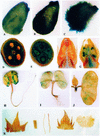Molecular characterization of the cotton GhTUB1 gene that is preferentially expressed in fiber
- PMID: 12376634
- PMCID: PMC166596
- DOI: 10.1104/pp.005538
Molecular characterization of the cotton GhTUB1 gene that is preferentially expressed in fiber
Abstract
Each fiber of cotton (Gossypium hirsutum) is a single epidermal cell that rapidly elongates to 2.5 to 3.0 cm from the ovule surface within about 16 d after anthesis. A large number of genes are required for fiber differentiation and development, but so far, little is known about how these genes control and regulate the process of fiber development. To investigate gene expression patterns in fiber, a cDNA, GhTUB1, encoding beta-tubulin was isolated from a cotton fiber cDNA library. The analyses of RNA northern-blot hybridization and reverse transcriptase-polymerase chain reaction demonstrated that GhTUB1 transcripts preferentially accumulated at high levels in fiber, at low levels in ovules at the early stage of cotton boll development, and at very low levels in other tissues of cotton. The corresponding GhTUB1 gene including the promoter region was isolated by screening a cotton genomic DNA library. To demonstrate the specificity of the GhTUB1 promoter, the 5'-flanking region including the promoter and 5'-untranslated region was fused with the beta-glucuronidase reporter gene. The expression of the reporter chimera was examined in a large number of transgenic cotton plants. Histochemical assays demonstrated that GhTUB1::beta-glucuronidase fusion genes were expressed preferentially at high levels in fiber and primary root tip of 1- to 3-d-old seedlings and at low levels in other tissues such as ovule, pollen, seedling cotyledon, and root basal portion. The results suggested that the GhTUB1 gene may play a distinct and required role in fiber development. In addition, the GhTUB1 promoter may have great potential for cotton improvement by genetic engineering.
Figures





References
-
- Arthur JC. Cotton. In: Kroschwitz JI, editor. Polymers: Fibers and Textile: A Compendium. New York: Wiley; 1990. pp. 119–141.
-
- Basra AS, Malik CP. Development of the cotton fiber. Int Rev Cytol. 1984;89:65–113.
-
- Chu B, Wilson TJ, McCune-Zierath C, Snustad DP, Carter JV. Two β-tubulin genes, TUB1 and TUB8, of Arabidopsis exhibit largely nonoverlapping patterns of expression. Plant Mol Biol. 1998;37:785–790. - PubMed
-
- Cleveland DW, Sullivan KF. Molecular biology and genetics of tubulin. Annu Rev Biochem. 1985;54:331–365. - PubMed
Publication types
MeSH terms
Substances
Associated data
- Actions
- Actions
LinkOut - more resources
Full Text Sources
Other Literature Sources
Molecular Biology Databases

